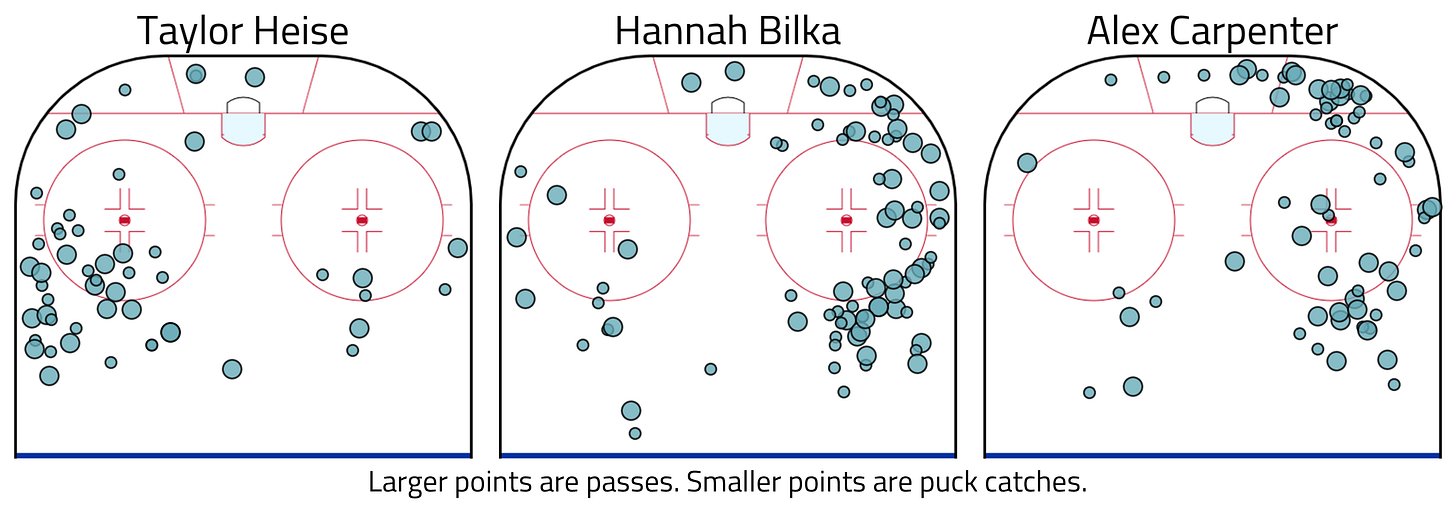Tactics: Organized Chaos on the Power Play
Analyzing the PP strategies of Team USA at the World Championship
On the power play, structured but deceptive movement patterns can allow teams to create “organized chaos” in the OZ.
From a technical standpoint, this requires good vision and anticipation, as well as strong passing, stickhandling and communication skills on the part of the players deployed on the ice.
The power play (PP) personnel of the USNWT stack these skills very well and as a result, team USA is currently sitting on top of the rankings at the World Championship in Denmark, while shooting for 39% (7/18) on the PP.
Hence, today we will attempt to use stats and video analysis to understand how they leverage this idea of “organized chaos” on the PP.
USA PP1 – Umbrella
Team USA’s first unit (PP1) consists of 4 forwards (Knight, Carpenter, Bilka and Heise) and 1 defender (Keller) positioned in an umbrella formation.
The center of gravity of this PP unit is on the right side with Bilka and Carpenter initiating and receiving a high volume of passes. We also note that the main objective of this power play is to set up one of the forwards for a shot.
To achieve this, PP1 players leverage passing patterns that begin with Megan Keller sending the puck down to the flank players (Bilka and Heise).
Once the puck is sent down to the forwards, the “organized chaos” of this unit rolls into action relying on mobile flank players.
The freedom that the flank players enjoy opens up the possibilities for forward permutations. The unpredictability of these movement patterns lies in structured routes that may be deviated from, on occasion.
While this unit’s movement patterns are structured for the most part, Team USA’s players will not hesitate to switch things up occasionally. And when allowing for creativity and deception to take over, switching things up results in good scoring chances through “organized chaos”.
Observing the puck touches of the 3 most active forwards on this power play (Bilka, Carpenter and Heise) gives us a pretty good idea of how the “organized chaos” plays out in this unit.
With the use of permutations, Bilka and Carpenter are dual threats covering the right flank.
Their goal is to either put a puck towards the net, pass it to Keller to prolong the possession sequence or change the point of attack by leveraging a cross-ice pass to set up Heise for a shot.
When that cross-ice seam is successful, that’s when the chaos unfolds: the opposing goalie and the opposing D both have to shift their focus to the weak side to block this high danger chance.
Heise, on the left flank, has similar options as she can gain the middle of the ice to shoot or switch it up by feeding the puck to Bilka for a shot. In recent games, Bilka and Heise have also been switching flanks, adding more options and unpredictability to the equation.
In short, through structure, localized advantage and movement, USA’s PP1 is able to implement “organized chaos”:
USA PP2 – 2-3 Spread
Team USA’s PP2 is comprised of 3 forwards (Coyne Schofield, Kessel, Roque) and 2 defenders (Harvey and Barnes) within a 2-3 spread.
The puck touches in this unit are evenly distributed between both Ds and flank players. In terms of passing patterns, we are mostly looking at peripheral puck movement until Harvey or Barnes sets up for a shot with net front presence (Roque) or the forwards try to gain the high value of the ice low in the slot.
But, with this unit, the “organized chaos” is not a specific result of the movement patterns of players, but rather stems from the structure of the PP itself. As we would expect, players in this 2-3 spread are placed in a standard formation and while permutations do occur from time to time, most of the puck touches occur in the main area of coverage for each player.
More precisely, the “organized chaos” in this unit stems from the difference in structure between PP1 and PP2. In PP1, we had 3 players high and 2 players low. PP2, on the contrary, has 2 players high and 3 players low.
As Jack Han mentioned recently, when we were at McGill, the team ran two different power play structures: a standard 1-3-1 formation for PP1, followed by a 2-3 spread for PP2. And from experience, the fact that we ran two different PP structures contributed to creating havoc for the opposing PKs, both in preparation for games and on the ice.
In terms of game preparation, two different PP structures meant that opponents needed to double down on the pre-scout required to understand our PP strategies. They also had to spend more time during video meetings explaining our different strategies to the players.
And even when pre-scouting our strategies efficiently, the inherent unpredictability of hockey combined with our different structures caused problems for opponents in-game, creating confusion and leading to coverage mistakes on the PK.
In a similar way, Team USA is able to condition opponents to certain patterns of play with PP1 and switch it up right away with a different structure as PP2 rolls along.
As such, this can be another tactic to enhance the feeling of “organized chaos” in the OZ:
If you are a coach who wants to learn more about how to leverage hockey analytics efficiently at any level, Jack Han & I recently released a course that may interest you.
In this 2-hour course, split into 9 different chapters, Jack & I share our experiences working with different organizations worldwide and discuss best practices when starting to use analytics in coaching.










Absolutely outstanding work.